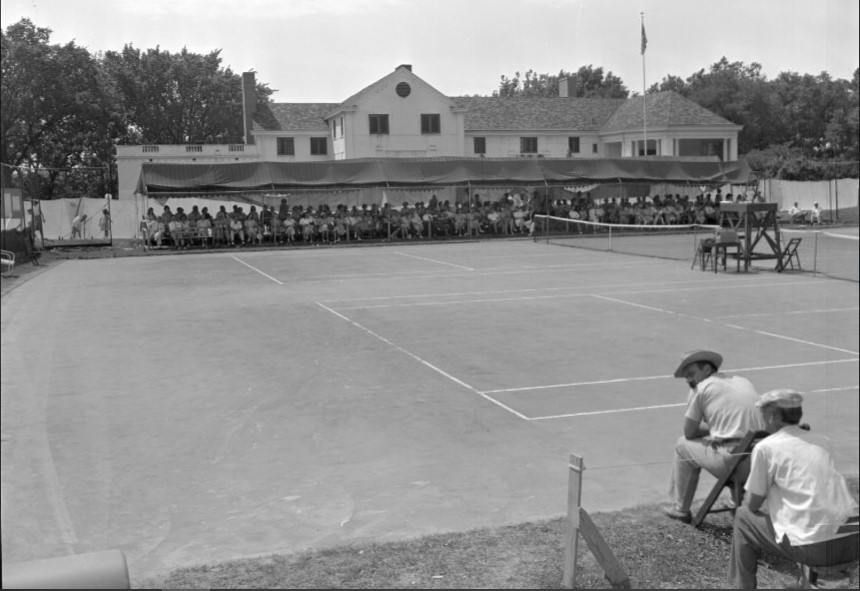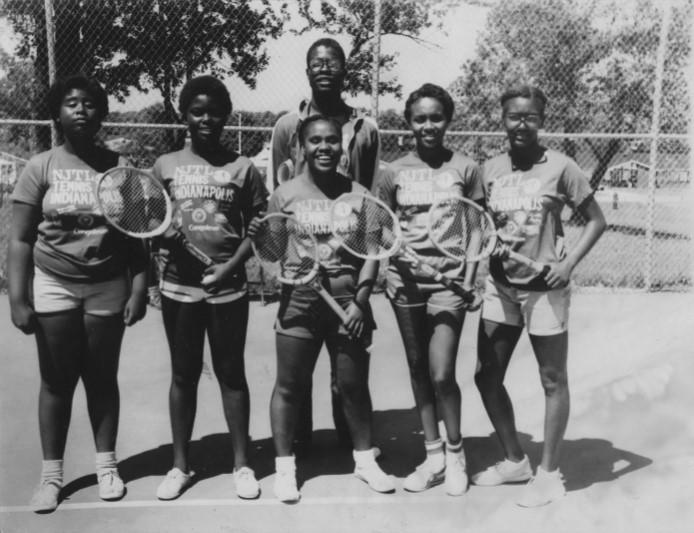Little information has survived concerning tennis in Indianapolis in the 19th century. The (IAC) hosted the earliest recorded tournaments in the city in the summer of 1887. The IAC sponsored three city tournaments that year, but the sport did not take root in Indianapolis until after the first state tournament held at Irwin Field (see ) in 1907. Over 100 entrants from all over Indiana competed. The tournament’s success prompted tennis enthusiasts from the Indianapolis Country Club, North Illinois Street Country Club, and the Irvington Tennis Club to form the Indianapolis Tennis Association (ITA) later in 1907 (see ). The ITA had its courts on East 10th Street (where now stands), and worked with other clubs to promote tennis throughout the city.
By the 1920s Indianapolis was recognized nationally as a tennis center, ranking just behind New York, San Francisco, and Philadelphia. The Western Open, the oldest amateur tournament in the United States, came here for the first time in 1922, bringing the world’s top-ranked tennis players with it. Woodstock Country Club was the host, and the tournament was so successful that the Western Tennis Association decided that Indianapolis would be the host city every other year. In the late 1920s and 1930s Johnny Hennesy, a product of the old Hawthorne Tennis Club located at 34th Street and Central Avenue, brought fame to the city by winning the Western Open and playing for the U.S. Davis Cup team.

Tennis experienced a decline in interest in the 1950s but rebounded in the 1960s. Traditionally known throughout the city as “tennis week,” the Western Open was the social event of every other summer. Local families vied for the privilege of billeting players, and many residents postponed their summer vacations until after the tournament. Indianapolis began hosting the tournament every year in 1966. This arrangement was shortlived, however, because of the United States Tennis Association’s (USTA) decision to move the U.S. Clay Court Championships to Indianapolis from Milwaukee in 1969 (the Western Open moved to Cincinnati). The Clay Courts enjoyed great initial success in Indianapolis. Woodstock hosted the tournament from 1969 until 1974 when low seating capacity forced its move to the Indianapolis Racquet Club. The U.S. Open’s switch from grass to clay in 1975 made the Clay Courts, always the last major tournament before the U.S. Open, a popular event among the world’s top-ranked players. Demand for tickets spurred the construction of the 15,000-seat Indianapolis Sports Center downtown in 1978. The Sports Center began hosting the Clay Courts in 1979.
The Clay Courts’ fortunes suffered a major reversal after the U.S. Open moved from clay to hard courts in 1978. Top players began entering hard-court tournaments as tune-ups before the Open, and by 1986 the Clay Courts managed to draw only one player ranked among the men’s top 20. The following year the Clay Courts lost the women’s draw, and in the fall the USTA moved the Clay Courts to Wild Dunes, South Carolina after Indianapolis announced its intention to pave the Sports Center courts to draw top-ranked players to the city. In the spring of 1988 the Sports Center’s courts were paved over as part of a $13 million improvement plan that included the construction of an indoor tennis complex. The move paid off. In December 1988, the USTA made the Sports Center one of its regional training centers. The new hard-court tournament, that RCA sponsored annually became popular among the world’s top-ranked men as a tune-up for the U.S. Open.

Indianapolis hosted its first Women’s Professional Tennis tournament in 1972 when the Virginia Slims Grand Prix stopped at the . Women’s pro tennis returned ten years later when Virginia Slims made the Indianapolis Racquet Club a stop on its Ginny circuit, a series of tournaments designed for young women just entering the top ranks of professional tennis. Virginia Slims continued to hold a tournament in Indianapolis until 1987 when the Racquet Club stop became part of the Kraft series of Women’s Tennis Association tournaments. In 1993 the Indianapolis tournament was moved to Schenectady, New York.
From 1975 to 1978, Indianapolis was home to the Indiana Loves of the World Team Tennis (WTT) League. The Loves played their home matches at the for three seasons before moving to in 1978. The Loves folded after the 1978 season, along with the rest of the WTT franchises.
High school tennis was slow to develop on the state level. In Indianapolis, , Tech, Cathedral, and Broad Ripple high schools competed in the first city high school tournament in 1950. By the end of the decade Scecina, Howe, and high schools had joined the field, but the first state tournament was not played until 1967. The boys’ finals were moved to North Central High School after the completion of a 27-court complex there in 1971, and the girls had their first finals there in 1974. Both finals are still held at North Central, where the host Panthers have experienced tremendous success. The girls have won the championship 8 times since 1976, while the boys have won 13 times over the same period, including 5 straight titles from 1982 through 1986.

Youth tennis programs have enjoyed great support in Indianapolis over the past 25 years. In 1969 Barbara Wynne began offering public tennis lessons for 100 children in . Her classes developed into the city’s two largest youth tennis programs, with the Riverside Park program growing to 500 participants when the National Junior Tennis League (NJTL) took it over in 1973. By 1980 the NJTL offered free tennis lessons to 2,500 Indianapolis youths at 20 different sites. In 1993 the organization served over 3,000 participants at 24 different sites. In 1973 Wynne moved to North Central and started the Washington Township Schools Community Tennis Program. Over the past 20 years her program, with 1,000 players in 1993, has produced some of the best players in the state and contributed greatly to North Central’s success.
*Note: This entry is from the original print edition of the Encyclopedia of Indianapolis (1994). We are currently seeking an individual with knowledge of this topic to update this entry.

Help improve this entry
Contribute information, offer corrections, suggest images.
You can also recommend new entries related to this topic.